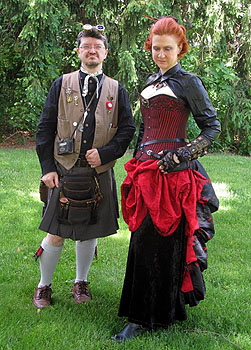
Holding Costumes Together: Sewing, Gluing, and Safety Pins
While you may have started out using items from your closet and thrift stores, you may eventually want to modify these items even though you're not by any means creating new items. For this, you're going to have to find some way of holding your new creations together.
Sewing
Pros: Sewing is generally the most secure method of fastening fabrics to one another. For small jobs (such as sewing the folds of a bustle), a needle and thread is fine. For larger projects, you'll want a sewing machine, which you can find in a wide range of prices. Anything I do requires only a basic stich, so any cheap machine will work.
Cons: Sometimes the material is too thick for either hand stitching or a sewing machine. Common problems include heavy leather, layers of thin leather, heavy braid.
Also, the area in question might not be accessible to a sewing machine, such as the inside of a sleeve. if you were starting from scratch, you'd make your changes to a sleeve before attaching it to the shoulder, but we don't have that luxury when modifying pieces.

Pros: There are times when sewing isn't strictly necessary. When I bustle up skirts, I don't always sew the folds in place. If they aren't going to be visible, I've just left the safety pins in.
One example is my red outfit, in which the outer red skirt's folds are entirely safety pinned, although the black and red back bustle is sewn.
Cons: They only work on very small areas, and even then only in some situations.
Fabric Glue
Pros: It gets into spaces your sewing machine can't. It works well on fabrics that flex a lot, while heavier glues either crack from the movement or make the fabric unnaturally stiff. It can also be used to keep materials from fraying.
On many (but not all) fabrics it dries clear, but test a sample first. If the join isn't going to be visible (such as when gluing braid to fabric) it doesn't matter if it's clear.
Cons: Fabric glue works best on thinner fabrics, as it can't hold a lot of weight.
Hot Glue
Pros: Works better on heavier fabrics. Also works for adding decorations.
Cons: It doesn't flex well. The longer the length of glue, the more problematic it becomes .
Superglue
Pros: When nothing else seems to work, there's superglue. It's best in small doses.
Cons: It's fast-drying properties make it difficult to get materials into place. It's very unforgiving in this manner, frequently not allowing you to peel apart materials to try again.
It's lousy on most fabrics, and it's lack of flexibility is the least of its problems. It soaks into fabric, when you want it on the surface where it can bond pieces together. It can also soak down to whatever material is beneath your project, gluing the project to the table....or your fingers.
Multi-Purpose Glue
The only brand I have used is a liquid called SureFlex by Living Solutions, so read labels and make sure a glue labeled "multi-purpose" will do what you want.
I picked SureFlex up at a con after my hot glue cracked and trim was falling off my costume. SureFlex advertises its ability to create a flexible bond that won't crack, and my experience was that it did just that. Nothing more detached from my costume all weekend.
Additional Tools: Wax Paper
Wax paper is resistant (although not immune) to glue, so covering your work space with it helps avoid the issue of projects sticking to your table.
Markers
I occasionally use markers to clean up ugly imperfections. For example, I was gluing yellow fabric to black leather and covering the edges with braid. The braid occasionally missed its mark, and yellow fabric poked out. The solution was to color the fabric black. The only person likely to notice the imperfection is me.